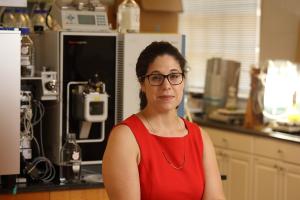
Soon, environmental engineer Lisa Colosi Peterson will have a heap of red and green data to read. Her team has charted Virginia’s 133 counties and independent cities, and to each, they’re assigning color-coded yes’s and no’s. These designations will determine whether a given county can practically put two types of carbon capture and storage technology in place based on cost and available resources. They’ll have a lot of data to parse, which Colosi Peterson welcomes.
“I’m an engineer,” said Colosi Peterson, a professor in the Department of Civil and Environmental Engineering and an affiliated faculty member of UVA’s Environmental Institute. “My job is to look at complicated, technologically rich systems and make them tractable. We’re trying to help people imagine these technologies as they would operate in their little corner.”
Virginia’s Path to Net-Zero Emissions
The project is part of the Environmental Institute’s Climate Restoration Initiative, which aims to inform the adoption of solutions in negative emissions, or carbon dioxide removal, in Virginia. According to a 2022 report conducted by researchers at the Environmental Institute, negative emissions solutions will be critical in enabling the state — and the wider U.S. — to help keep the global temperature from rising more than two degrees Celsius above pre-industrial levels. In 2014, the Paris Agreement set that goal for the world to avoid the most catastrophic effects of climate change.
The 2022 CRI report found that reliance on natural strategies for sequestering carbon dioxide won’t cut it if Virginia is to achieve net-zero emissions and keep to the aims laid out in Paris. To remove an additional estimated 40 million tons of carbon dioxide per year, the state will need to look not only at measures like reforestation and coastal ecosystem restoration, but also at engineered solutions. Colosi-Peterson’s group is focused on the feasibility of two such solutions: bioenergy with carbon capture and storage (BECCS) and direct air capture with carbon storage (DACCS). DACCS draws carbon dioxide directly out of the atmosphere and stores it underground in geologic formations. BECCS is an alternative energy solution that involves growing biomass feedstocks like switchgrass and corn, burning them as biofuels to make electricity, and intercepting their carbon dioxide emissions to store them underground.
Both technologies create a net movement of carbon dioxide away from the atmosphere and into the ground, which is the opposite of what we’ve been doing for 200 years by extracting fossil fuels, Colosi Peterson explained. And both technologies could go beyond stopping the state from adding to emissions of fossil fuels — which solar power and electric cars help us do — to actually run climate change in reverse, as some describe the work of carbon dioxide removal.
“We not only need to find ways to stop emitting as much as we have, we also need some amount of negative emissions,” Colosi Peterson said. “If we want to be net zero and avoid the worst catastrophes, we need minus 20 gigatons of carbon coming out of the atmosphere. That’s like half as much as we’re putting out right now. Now, we have to find a way to take it out.”
The two solutions have shown promise in Virginia in terms of the state’s biophysical and socio-technical resources, like weather, water, highways, and skilled labor. But where either or both technologies should be set up from county to county is still unclear, Colosi Peterson said.
Empowering Local Communities
Working from what they know about the resources available and how the technologies work, her team is estimating the costs for individual counties to deploy the technologies relative to the incentives the federal government offers to cover them. “We’re imagining, what is the business proposition?” Colosi Peterson said. “To what extent would it make sense for individual counties in Virginia to decide that they wanted to do this? If we can screen to find the most promising locations where it would be easiest to do, we’ll build them, and we’ll see how it goes from there.”
The team will also estimate the total potential carbon dioxide removal if every county adopted the solutions where they’re found to be feasible. Once they finish processing the results, which they’re working on now, the researchers will share the information with local decision-makers.
Colosi Peterson plans to publish the results and host a series of workshops with representatives of state agencies.
“In climate decision-making, it’s historically been this top-down mode of, 'Well, the diplomats and the top climate scientists will decide what we do,'” Colosi Peterson said. “Now, it’s time to decide what we could and will do when thinking about each of our own communities, and to what extent those technologies are compatible with what we have and what we want.”